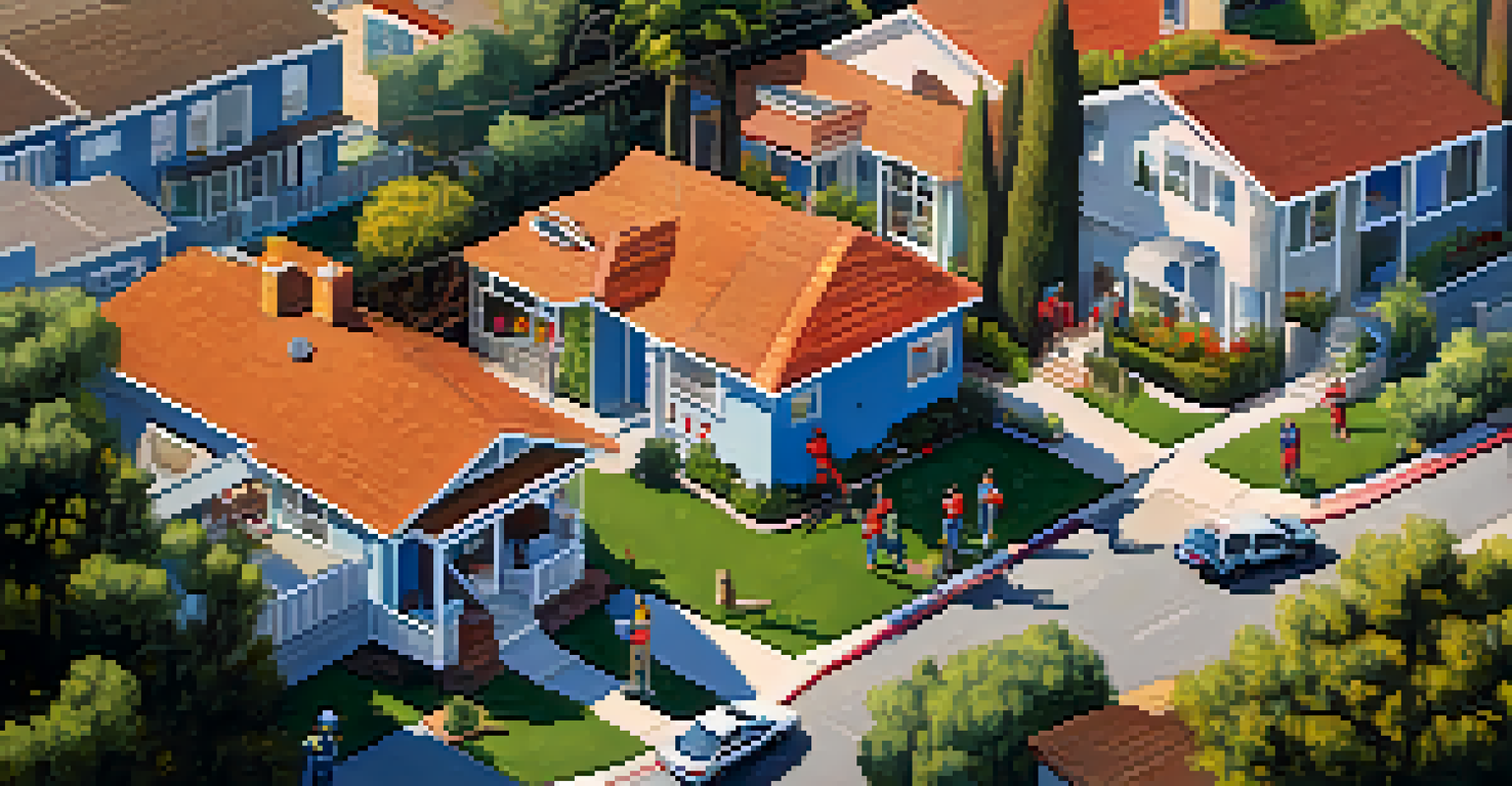Wildfires in Los Angeles: Climate Change and Fire Management

Understanding the Wildfire Landscape in Los Angeles
Los Angeles is no stranger to wildfires, with its unique geography and climate contributing to an environment ripe for fire. The combination of dry Mediterranean weather, Santa Ana winds, and a variety of vegetation creates a perfect storm for fire outbreaks. Each year, as temperatures rise, the risk of wildfires increases, impacting communities and ecosystems alike.
The forest is not just a collection of trees; it's a complex ecosystem that thrives on fire as part of its natural life cycle.
In recent years, wildfires have become more frequent and intense, leading to widespread destruction and loss. This trend has made it crucial for residents to understand the factors at play, including how climate change exacerbates these conditions. By recognizing the landscape's vulnerabilities, we can better prepare for the inevitable fire season.
Moreover, the consequences of these wildfires stretch beyond physical damage; they affect air quality, wildlife habitats, and local economies. Understanding the wildfire landscape helps residents and officials alike develop strategies to mitigate risks and protect their communities from these devastating events.
The Role of Climate Change in Increasing Fire Risks
Climate change is undeniably one of the driving forces behind the increased frequency and severity of wildfires in Los Angeles. Rising temperatures and prolonged droughts create conditions that are conducive to fire ignition and spread. As climate patterns shift, the historical understanding of fire seasons is being challenged, leading to unpredictability.

For instance, warmer winters can lead to earlier plant growth, which eventually dries out and serves as fuel for summer wildfires. This cycle has become more pronounced in recent years, making it essential to study how climate change influences these patterns. With each passing year, communities face the daunting reality of adapting to a new normal.
Wildfires Threaten LA Communities
Los Angeles faces increasing wildfire risks due to its unique geography, climate change, and urban expansion.
Addressing climate change requires collective action, from government policies to individual choices. By acknowledging the connection between climate change and wildfires, residents can engage in discussions about sustainable practices and support initiatives aimed at reducing greenhouse gas emissions. Together, these efforts can help mitigate future fire risks.
Historical Context: Wildfires in Los Angeles
Wildfires have been a part of California's history long before the term 'climate change' entered our vocabulary. Indigenous people managed landscapes with controlled burns, a practice that significantly reduced the fuel load and prevented catastrophic fires. Unfortunately, as urban development expanded, these traditional methods were largely abandoned, leading to increased wildfire risks.
Climate change is not just an environmental issue; it is a threat to our very existence, and we must act decisively to mitigate its impacts.
In the 20th century, the relationship between humans and wildfires shifted dramatically. With more people living in fire-prone areas, known as the wildland-urban interface, the stakes grew significantly. Historical events, such as the devastating 1993 fire in Malibu, serve as reminders of how quickly wildfires can escalate, impacting lives and livelihoods.
Understanding this historical context is crucial as it highlights the need for effective fire management strategies. By learning from past mistakes and successes, we can implement better practices for both prevention and response, ensuring that Los Angeles is more resilient to future wildfires.
Modern Fire Management Strategies in Los Angeles
In response to the growing threat of wildfires, Los Angeles has adopted a range of modern fire management strategies aimed at reducing risks. These strategies include controlled burns, vegetation management, and community education programs that empower residents to take an active role in fire prevention. The goal is to create a proactive approach that minimizes the chances of catastrophic fires.
Controlled burns, when conducted safely and under the right conditions, can help reduce excessive vegetation and create firebreaks. These practices not only lower the fuel load but also support the natural ecosystem. Additionally, community outreach programs educate residents on fire safety measures, creating an informed population that knows how to respond during a fire emergency.
Community Preparedness is Crucial
Educating residents and developing emergency plans significantly enhance community resilience against wildfires.
However, modern fire management is not without its challenges. Budget constraints, limited personnel, and climate unpredictability can hinder efforts. Continued investment in fire management and community involvement is essential for ensuring that these strategies remain effective amid changing conditions.
The Importance of Community Preparedness
Community preparedness plays a vital role in reducing the impact of wildfires in Los Angeles. Residents who are well-informed about fire risks and evacuation routes are better equipped to respond when danger strikes. Developing personal and community emergency plans ensures that everyone knows what to do before, during, and after a wildfire.
For example, local organizations often host workshops and drills to help residents practice their response to wildfires. These activities not only build confidence but also foster a sense of community as neighbors come together to support one another. Knowing that your community is prepared can significantly reduce anxiety during fire season.
Ultimately, community preparedness can save lives and property. By prioritizing education and proactive measures, Los Angeles residents can create a culture of resilience, ensuring that they are ready to face the challenges of wildfires head-on.
The Role of Technology in Fire Management
Technology is transforming fire management in Los Angeles, offering innovative solutions to traditional challenges. From satellite imagery and drones to advanced modeling software, these tools enhance the ability to predict and respond to wildfires more effectively. By leveraging technology, fire agencies can streamline their operations and improve communication during emergencies.
For instance, real-time data collection allows firefighters to assess conditions on the ground quickly. This information helps them make informed decisions about resource allocation and evacuation orders. Additionally, predictive modeling can identify potential fire risks, allowing for early intervention before a small spark turns into a raging inferno.
Technology Enhances Fire Management
Innovative tools like drones and predictive modeling improve the ability to manage and respond to wildfires effectively.
As technology continues to evolve, it presents exciting opportunities for improving fire management strategies. By embracing these advancements, Los Angeles can enhance its resilience against wildfires, ultimately protecting both people and the environment.
Looking Ahead: The Future of Wildfires and Management
As we look to the future, the reality is that wildfires in Los Angeles are likely to remain a significant concern. Climate change continues to reshape our environment, making it essential for residents and officials to adapt to these changing conditions. The future of fire management will rely on a combination of innovative strategies, community involvement, and ongoing education.
Proactive measures, such as improved land-use planning and enhanced forest management, will be crucial in mitigating wildfire risks. Additionally, engaging with scientific research can provide valuable insights into how climate change will impact fire behavior, enabling better preparedness and response strategies.

Ultimately, the fight against wildfires in Los Angeles is not just a matter of managing fire when it occurs, but also about creating a sustainable future. By embracing collaboration, technology, and education, we can foster a community that thrives in harmony with nature, even in the face of wildfire challenges.